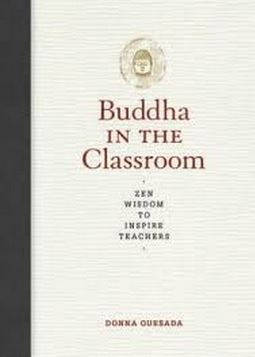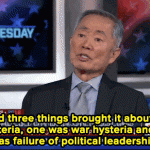Subtitled: “Zen Wisdom to Inspire Teachers,” this is a book filled with much more than just “Zen” wisdom and it will surely inspire pretty much anyone who reads it.
“The Burned-Out Professor.”
To be fair, some of my appreciation for the book is purely selfish: the book feels like it was written specifically for me. The author, Donna Quesada, is a philosophy professor in California, a Buddhist, a yoga instructor, a connoisseur of world-wisdom, and a watcher of good movies. She tells us the book is in part a product of a particularly hard semester at her college and part one of the book is called “The Burned-Out Professor.” At 35 and just finishing grad-school, with just a few courses of my own and a hand-full of TA posts under my belt, I’m nowhere near burnout. But in academia it does seem to be all around me. I’ve faced mini-burnouts at the ends of semesters, as many students do, I have seen friends end their studies for various reasons (burnout often being one of them), and I know that frustration with teaching, grading, university bureaucracy, and/or government policy-makers can hit professors even before they ever step into the classroom.
So some strategies with dealing with burnout sounded quite appealing, even if only as a preventative measure. One area where I am burned out is in certain aspects of Western philosophy inside academia, where, as Prof. Quesada describes, “It started to feel like a game–a board game, where you move your marker around a make-believe course and try to advance to the end first. You identify the logical fallacies–the begging questions, the slippery slopes…. You call out all the unsupported assumptions, and you win. You bask in the self-satisfaction that comes from weeding through the mess of fictitious claims. But the pleasure runs thin quickly, and truth still seems far away.”
Realizing this, Quesada stayed in philosophy, but moved Eastward in her focus where the emphasis isn’t on thinking right thoughts, but on the clarity of the mind itself:
When the water is clear, you see the infinite possibilities, Zen says. – (p.22)
Buddhist thought in general has maintained a purpose, a goal toward which the little marker-moving is directed. It has connected abstract thought to practice toward that goal, meditation, which in turn pivots around proper ethical conduct in the world. Even the most abstract logic-chopping of Indo-Tibetan Buddhism can be best understood within the larger framework of the spiritual exercises of the Buddhist tradition, as I saw Matthew Kapstein discuss in a 2011 lecture at Columbia University titled: “‘Spiritual Exercise’ and the Interpretation of Buddhist Philosophy in India and Tibet.”
Section 2 of the book, by far the largest section, deals with life in the classroom. Each chapter is built around an anecdote which traces its way through the course of her semester. In the beginning, there is add-drop (or at least “add” where students try to get direct permission to get into an already-full class). Setting the tone for the whole semester can seem to fall on those first precious classes. Every extra student is a potential distraction for the others as well as extra time and work for the teacher. On the other hand they might be great students, eager to get in and helpful to those around them. If the class was meant for 25, what does one do when nearly 40 show up on day one? (This actually happened to me years ago when I taught Tibetan Buddhism. I let everyone in, found a new, bigger room, shifted the structure a bit, and in the relative chaos that ensued, the class weened itself down to about 25.) Quesada’s wisdom: no need for a rigid or open-door policy. Connect individually with each student wishing to add, even if it’s only to say there’s no more room. It can seem like compassion to just let everyone in, but students deserve smaller classes and the additional intimacy that creates.
Let’s just see how it goes, Zen says. – (p.36)
“There is No Beginning and No End.”
The next chapter, on grading papers, is humorously subtitled, “There is No Beginning and No End.” The theme is presence and simply tackling one thing at a time, even when staring down a mountain of work in front of you (note to self regarding my ph.d. thesis…). She even draws on the experiences of Pam Reed, an ultrarunner, who manages to run incredible distances by simply making it to the next marker, and the next, and the next, and so on. Stay focused on what’s here and now, and simply move forward, and you’ll make it. The lesson is profound, but easily overlooked in this age of endless wants and seemingly endless tasks.
The book continues with what seems like a whole life’s worth of lessons and wisdom. Again, the stories revolve around the classroom, but the lessons reach all of us in situations throughout our lives: when to let go, to forgive, to carry a big stick, and when to smile in the face of the absurd.
Like most any Zen/Buddhism book, the answer is more often than not to take a look at yourself. What are you bringing to this problem that only seems to be out there. Can a change of mind fix things? I laughed out loud when she mentioned the example of a blaring siren, having lived for a few months on a major road in South London, where police and ambulances would pass by every 10-15 minutes, sirens blasting. But Quesada suggests that this may be seen as an annoyance on the one hand (as it certainly was for me and my flatmates) or it may be seen as the sound of somebody’s life being saved. Ah, the importance of perspective, and of getting beyond the confines of your own desires (for peace and quiet).
But as with any Zen or Buddhism book, it is the humanness of the author that needs to seep through, to make a connection with the reader that will make him/her remember the stories, as well as the wisdom within them. And Donna Quesada has brought her humanity fully to these pages, in part by focusing on the very deepest of her struggles, but also through her wit and sincerity.
I don’t think a better book can be found for a young teacher or aspiring teacher today, especially one with an interest in Buddhism. And this is also a book I’ll pass amongst all of my friends and family (careful each time to get it back!), as the wisdom goes well beyond the classroom and academia. Coincidentally (or not), the book is roughly the same size, weight, and color of another exceptional book for teachers, Jay Parini’s “The Art of Teaching.”
You can find Buddha in the Classroom: Zen Wisdom to Inspire Teachers at amazon here. I originally reviewed this book in 2011 here.













